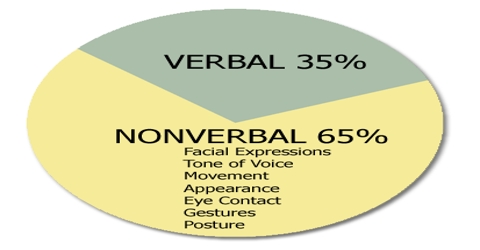Limitations of Non-verbal Communication
Non- verbal method of communication can be used simultaneously with written and oral methods of communication. Although non- verbal communication enjoys a lot of advantages in exchanging information, it has some limitations. Its key limitations are as follows:
- Lack of formality:
Non-verbal communication is not formal and well structured as like as written and oral communication. Most of the cases, people instinctively and usually engaged in non-verbal communication by moving the various parts of the body. So it cannot be used in any formal situation.
- Expressing contradiction with the verbal statement:
Though non-verbal cues help in expressing the meaning of verbal messages more accurately, they may express contradictory meaning with verbal statement. Nonverbal messages can be quite inaccurate because there is no use of verbal words so it becomes very difficult how the other perceives.
- Ambiguity:
When the sender uses the ambiguous or unfamiliar non-verbal cues, the receiver may fail to understand the meaning of the message. Difficult to understand and requires a lot of repetitions in non-verbal communication. As a result, communications between them may also fail.
- Culture boundness:
The use of non-verbal cues is generally culture-bound. Therefore, non-verbal cues of one culture cannot be used in another culture. Although some cues remain the same across cultures, their meaning differs significantly. The difference in a message can lead to negativity and offensive. For example, in the United States, a circle forming with the thumb and index finger indicates the symbol “OK” or “everything is right.” But in France, this symbol means “zero”, while it means “money” in Japan. However, the Japanese admire silence and consider it is a key to success.
- Lack of explanation of message:
Although non-verbal cues can convey a message like verbal communication, it cannot carry any explanation of the message to the receiver. Few people do not desire to use nonverbal skills. They think it may be unprofessional, unimpressive and less influential.
- The problem relating to preserving information:
Non-verbal communication occurs through various body movements, symbols, signs, colors, sounds, etc. Since it uses gestures, facial expressions, eye contact, touch, sign, sound, paralanguage, etc. for communicating with others, there is a great chance in deformation of information in non-verbal communication. As a result, such information cannot be preserved for use in the future.
- No rules
Nonverbal communication should not follow any rules, a formation like other communication, therefore, people instinctively connect in nonverbal movements. For example, some people have a tradition of shaking a leg while talking.
- Costly:
In some cases, non-verbal communication involves huge costs.
- Vague and imprecise:
Since in this communication, there is no use of words or language which expresses clear meaning to the receiver. No dictionary can precisely categorize them. Their meaning varies not only by culture and situation but by the level of purpose.
- Multi-channel:
Everything is occurrence at once and consequently it might be confusing to try to keep up with everything. Most of us merely do not do so, at least not intentionally. No party can talk about the exacting issues of the messages.
















